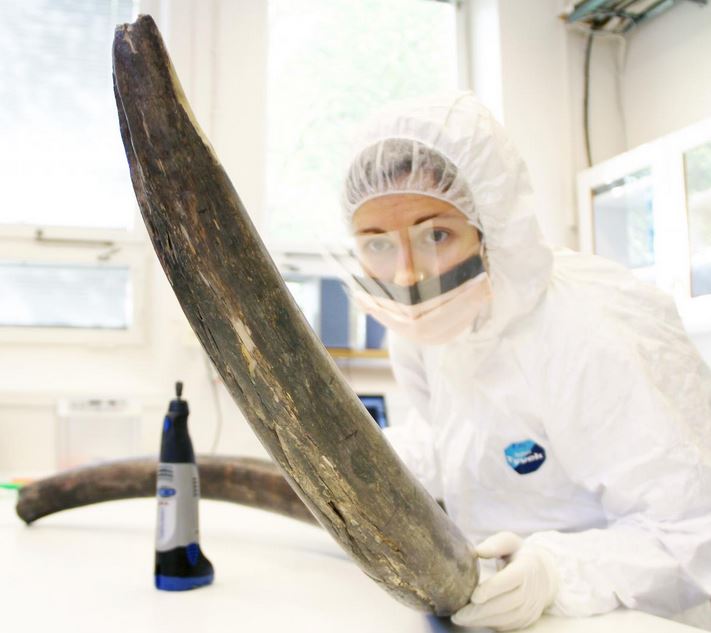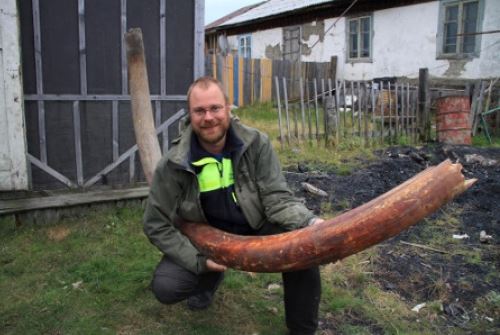Scientists have decoded the DNA of two Woolly Mammoths, providing further clues on how they became extinct. Before the last woolly mammoth on Earth died, the iconic giants had already suffered from a significant loss of genetic diversity.
The researchers, from the US, Russia, Sweden and Canada, wrote about their first complete genome sequences isolated from two ancient mammoth specimens in the academic journal Current Biology.
One of the specimens, representing the last woolly mammoth population on Wrangel Island, Russia, is thought to have lived about 4,300 years ago. The other specimen, estimated to be about 44,800 years old, was found in northeastern Siberia.

Eleftheria Palkopoulou holding a mammoth tusk in the ancient DNA lab at the Swedish Museum of Natural History. (Credit: Love Dalén. Image: Eurekalert)
The more recent of the two showed much lower genetic variation, including large stretches of DNA with absolutely no variation – evidence that it lived in a tiny population in which related mammoths unavoidably mated with each other.
Co-author, Love Dalén, who works at the Swedish Museum of Natural History, said:
“We found that the genome from one of the world’s last mammoths displayed low genetic variation and a signature consistent with inbreeding, likely due to the small number of mammoths that managed to survive on Wrangel Island during the last 5,000 years of the species’ existence.”
Ancient genomes not easy to sequence
Sequencing ancient genomes is not easy, said Dalén and Eleftheria Palkopoulou, who works both at the Swedish Museum of Natural history and Stockholm University. In most cases, the DNA is highly fragmented, damaged, and contaminated by DNA from microbes and sediments.
After considerable screening, the scientists managed to find two samples with extremely well-preserved mammoth DNA.
The genome of an individual animal is a mosaic of bits and pieces of DNA inherited from hundreds of ancestors. From a single genome it is possible to gather a vast amount of data about the population history of a species.
From DNA data, the scientists inferred that woolly mammoth populations declined considerably in the Middle or Early Pleistocene, between 250,000 and 300,000 years ago. Why this occurred is not yet clear.
After that early decline, the woolly mammoth suffered further severe declines at the end of the last glaciation, from which it never recovered.

Love Dalén with a woolly mammoth tusk in Siberia. (Image: Stockholm University)
Palkopoulou said:
“Only by generating high-quality genomes could we discover population-size changes far back in time, revealing two significant population crashes in the mammoth’s history.”
The scientists say they plan to continue sequencing genomes representing points in time in order to learn more about the woolly mammoth’s evolutionary history.
Dalén said:
“Sequencing the genomes from extinct animals will not only help us better understand the biology and history of these species, but can also provide important information on how and why species become extinct in general.”
Could we clone a mammoth?
According to the science, it should be possible to bring an extinct species, such as the mammoth, back to life by cloning it, says Beth Shapiro, associate professor of ecology and evolutionary biology at the University of California, Santa Cruz, in her new book “How to Clone a Mammoth”. As long as you have decoded their genome.
We could not clone dinosaurs, for example, because their DNA is lost for good. However, something might be done with more recently-extinct species, such as passenger pigeons, gastric-brooding frogs, and mammoths.
Prof. Shapiro said:
“I question if it’s something we should do at all, for many ethical and environmental reasons. I’m trying to separate the science from the science fiction, because too much of what people hear is science fiction.”
“In a field that’s so full of hyperbole, people should be armed with the facts so they can make informed decisions.”
Citation: “Complete Genomes Reveal Signatures of Demographic and Genetic Declines in the Woolly Mammoth,” Eleftheria Palkopoulou, Swapan Mallick, Pontus Skoglund, Jacob Enk, Nadin Rohland, Heng Li, Ayça Omrak, Sergey Vartanyan, Hendrik Poinar, Anders Götherström, David Reich and Love Dalén. Current Biology. Published 23 April, 2015. DOI: 10.1016/j.cub.2015.04.007.
Video – Mapping of Woolly Mammoth genomes
An interview with scientist Love Dalén at the Swedish Museum of Natural History explaining the findings.
